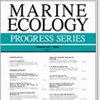Epinephelus morio 和 Lutjanus campechanus 挖掘的天然和人工栖息地的底栖改变和生物关联
IF 2.1
3区 环境科学与生态学
Q2 ECOLOGY
引用次数: 0
摘要
摘要:麻点是世界各地大量的海底特征,在西佛罗里达大陆架水域 110 米深处,麻点被认为是主要由红石斑鱼 Epinephelus morio 挖掘沉积物的地点,尽管红鲷鱼 Lutjanus campechanus 也会挖掘沉积物。2014-2017 年间,在佛罗里达潘汉德尔和半岛外的西佛罗里达陆架 17-110 米深的水域中,使用侧扫声纳(445 千赫)对 202 个此类挖掘点进行定位和部署立体诱饵远程水下视频阵列。三个挖掘栖息地类别包括:73 个在开阔沙地上的孤立挖掘点、74 个与低浮硬底相关的挖掘点和 55 个与人工礁石相关的挖掘点。不同地区、不同栖息地和不同深度的挖掘物的物理特征各不相同;平均直径(±1 SE)为 9.9 ± 0.3 米(范围:3-24.6 米)。非人工礁石周围的挖掘物有 6.9 ± 0.5 平方米(0-27.7 平方米)的裸露岩石,底栖生物生长覆盖了 33 ± 2% 的内部空间。共鉴定出 99 个鱼属。鱼类丰度最高的是孤立的挖掘区,其均匀度与挖掘的人工鱼礁相似;多样性较高的是挖掘的低凸硬底。L. campechanus 在潘汉德尔水域更为常见,尤其是在挖掘出的人工鱼礁上,这些人工鱼礁已垂直下沉到海底以下 0.8 ± 0.1 米处(即 48 ± 4% 的结构)。发掘区的这些生物和非生物特征凸显了E. morio生态系统工程服务的重要性,并为了解L. campechanus在创建或维持自然和人为栖息地发掘区方面的贡献提供了新的视角。本文章由计算机程序翻译,如有差异,请以英文原文为准。
Benthic modification and biotic associations at natural and artificial habitats excavated by Epinephelus morio and Lutjanus campechanus
ABSTRACT: Pockmarks are abundant seafloor features worldwide and, in West Florida Shelf waters <110 m deep, are thought to be sites of sediment excavation primarily by red grouper Epinephelus morio, although red snapper Lutjanus campechanus also excavate sediment. During 2014-2017, side-scan sonar (445 kHz) was used to locate and deploy stereo-baited remote underwater video arrays within view of 202 such excavations in waters 17-110 m deep on the West Florida Shelf off the Florida Panhandle and Peninsula. Three excavation habitat classes included 73 isolated excavations on open sand, 74 associated with low-relief hard bottom, and 55 associated with artificial reefs. Physical characteristics of excavations varied between regions, among habitats, and with depth; mean diameter (±1 SE) was 9.9 ± 0.3 m (range: 3-24.6 m). Excavations not around artificial reefs contained 6.9 ± 0.5 m2 (0-27.7 m2) of exposed rock, and epibenthic growth covered 33 ± 2% of the interiors. Members of 99 fish genera were identified. Fish abundance was greatest at isolated excavations which showed similar evenness to excavated artificial reefs; diversity was higher at excavated low-relief hard bottom. L. campechanus was much more common in Panhandle waters, especially at excavated artificial reefs which had subsided 0.8 ± 0.1 vertical meters below the seafloor (i.e. 48 ± 4% of the structure). These biotic and abiotic characteristics of excavations highlight the importance of E. morio’s ecosystem-engineering services and provide new insight into the contributions of L. campechanus in creating or maintaining excavations at natural and anthropogenic habitats.
求助全文
通过发布文献求助,成功后即可免费获取论文全文。
去求助
来源期刊

Marine Ecology Progress Series
环境科学-海洋学
CiteScore
5.30
自引率
8.00%
发文量
238
审稿时长
3 months
期刊介绍:
The leading journal in its field, MEPS covers all aspects of marine ecology, fundamental and applied. Topics covered include microbiology, botany, zoology, ecosystem research, biological oceanography, ecological aspects of fisheries and aquaculture, pollution, environmental protection, conservation, and resource management.
 求助内容:
求助内容: 应助结果提醒方式:
应助结果提醒方式:


